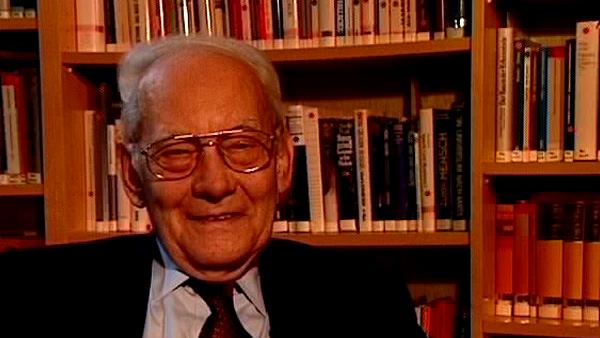NEXT STORY

Prions are protein molecules not viruses
RELATED STORIES

NEXT STORY

Prions are protein molecules not viruses
RELATED STORIES


|
Views | Duration | |
|---|---|---|---|
| 91. The versatility of viruses | 1 | 52 | 02:07 |
| 92. Polio: acceptance of errors | 47 | 02:13 | |
| 93. Virus detection methods | 43 | 03:56 | |
| 94. Prions are protein molecules not viruses | 54 | 02:14 | |
| 95. Autocatalytic proteins in BSE | 51 | 06:07 | |
| 96. Methods for early detection of prion diseases | 39 | 03:47 | |
| 97. Manfred Eigen and Ruthild Winkler's book The Laws of the... | 265 | 04:23 | |
| 98. The difference between chemical reactions and living systems | 82 | 03:32 | |
| 99. Why do we do research? | 69 | 02:18 | |
| 100. Talent | 135 | 00:43 |


We have already talked how to detect single molecules. If you can detect single nucleic acid molecules you can detect single virus particles, and that would be very important to do that. We just have developed recently such a method, by a combination of the fluorescence correlation spectroscopy with the PCR technology, or we use the other amplification technology. What is the advantage of it? Well, first of all by using in the fluorescence correlation spectroscopy, using primers, which are only for the purpose of detecting the virus and therefore be very specific to the virus, you have no wrong, false positives or negatives. You really... if there is a virus in there it will be detected by this. This is one very big advantage. The second advantage is that with this sensitive fluorescence technology, single molecule technology, you need only few replication rounds. So you can start... the more replication rounds you need the less precise is the technology because the enzyme somehow degrades and finally you don't get the amplification which you want, and for any quantitative method this would be very important, to know how many molecules did you amplify. Because, the most important use of these diagnostic techniques nowadays is not to detect for the first time the sickness, it's more when you get a treatment to detect the level of the virus, to find out whether the treatment helps and keeps the virus population down... the level down. And for that you need quantitative methods, you need... you have to say: alright, last week there were 'so-and-so' many viruses per litre of blood, this week there are 'so-and-so' many, and this is very important to do though. And the third advantage of this technology is all the present methods require quite a bit of ...
[Q] Material?
Not only material but also preparing the material, you have to make gels in order to find out whether your protein is in there or your nucleic acid which you look for. With the fluorescence you can really put your sample, your blood sample, with a mix, reaction mix, with your...
[Q] Cocktail?
Cocktail, yes, together into a plastic foil and seal it vacuum proof.
[Q] So it's also safety arguments.
Yes. And then you never have to open it again. You put it under your microscope, you run your amplification circles. All that goes automatically and you see under the microscope, like in a titration procedure, how your substance comes up. So it's much safer for mass tests, it's a much safer way to do so. This is technology we are trying to develop, and we have patents on that and we are co-operating also with industry on those projects.
Nobel Prize winning German biophysical chemist, Manfred Eigen (1927-2019), was best known for his work on fast chemical reactions and his development of ways to accurately measure these reactions down to the nearest billionth of a second. He published over 100 papers with topics ranging from hydrogen bridges of nucleic acids to the storage of information in the central nervous system.
Title: Virus detection methods
Listeners: Ruthild Winkler-Oswatitch
Ruthild Winkler-Oswatitsch is the eldest daughter of the Austrian physicist Klaus Osatitsch, an internationally renowned expert in gas dynamics, and his wife Hedwig Oswatitsch-Klabinus. She was born in the German university town of Göttingen where her father worked at the Kaiser Wilhelm Institute of Aerodynamics under Ludwig Prandtl. After World War II she was educated in Stockholm, Sweden, where her father was then a research scientist and lecturer at the Royal Institute of Technology.
In 1961 Ruthild Winkler-Oswatitsch enrolled in Chemistry at the Technical University of Vienna where she received her PhD in 1969 with a dissertation on "Fast complex reactions of alkali ions with biological membrane carriers". The experimental work for her thesis was carried out at the Max Planck Institute for Physical Chemistry in Göttingen under Manfred Eigen.
From 1971 to the present Ruthild Winkler-Oswatitsch has been working as a research scientist at the Max Planck Institute in Göttingen in the Department of Chemical Kinetics which is headed by Manfred Eigen. Her interest was first focused on an application of relaxation techniques to the study of fast biological reactions. Thereafter, she engaged in theoretical studies on molecular evolution and developed game models for representing the underlying chemical proceses. Together with Manfred Eigen she wrote the widely noted book, "Laws of the Game" (Alfred A. Knopf Inc. 1981 and Princeton University Press, 1993). Her more recent studies were concerned with comparative sequence analysis of nucleic acids in order to find out the age of the genetic code and the time course of the early evolution of life. For the last decade she has been successfully establishing industrial applications in the field of evolutionary biotechnology.
Tags: fluorescence correlation spectroscopy, Polymerase chain reaction technology, PCR, amplification technology, nucleic acid
Duration: 3 minutes, 57 seconds
Date story recorded: July 1997
Date story went live: 29 September 2010